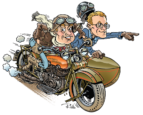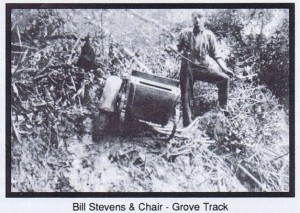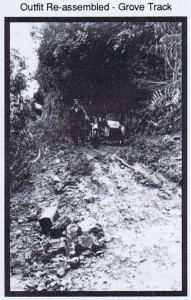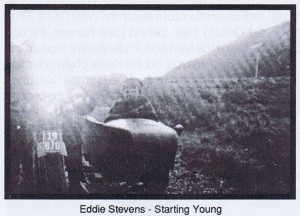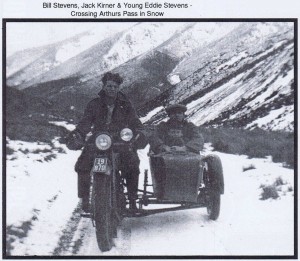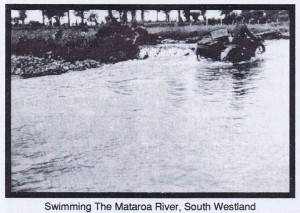Rex Knight is a person who probably has his own interesting stories about motorcycling having grown up with a father who was already into bikes and finished his last restoration of a long stroke featherbed Manx Norton at the healthy age of 84. However Rex has a different tale to tell, this one is about a person he met through his friend Jim Stevens by the name of Jack Kirner. Jack was a friend of Bill Stevens, Jims grandfather, and the two of them spent many a happy trip touring the South Island breaking in new tracks in the 1920s. It was first published in Twin Eagle magazine in 1994 and titled Two For The Road. Rex has kindly given us permission to retell Jacks story through Old Barnstormers Remembered. Thanks Rex.
Two For The Road.
The exploits of Jack Kirner, who’ll be 86 next birthday, and his mate Bill Stevens are an unsung part of New Zealand motorcycling history. The trips they made back in the twenties put to shame the wannabe element among todays motorcyclists who won’t ride far beyond the local pub without a backup truck.
Jack was born in Christchurch in 1908 and grew up in a pretty tough family. His dad was a hard man, any arguments at the meal table and he’d send the boys outside to settle it ¦. they were all pretty handy with their fists. Hunting was a favourite pastime. Able to laugh at the incident now, he remembers being woken one night by a rifle blast. His brother Joe had taken his .303 from the wall above his bed after waking to find a stray cat in the room, and shot it between the eyes. They turned the light on only to find that he’d blown the backside out of his best strides ¦. the eyes had been the moonlight reflecting off the two buttons for the rear strap of his braces!
Starting work at thirteen for shoe manufacturers Duckworth and Turner, Jack was into motorcycling by the time he was fourteen or fifteen. Among the bikes he owned were a couple of Indian Scouts, an LMC (it was belt driven, with an adjustable pulley giving a gearchange-free, widely variable range of final drive ratios), a 4hp Harley flat twin (similar to a Douglas), and his favourite, an Indian Chief 10/12.
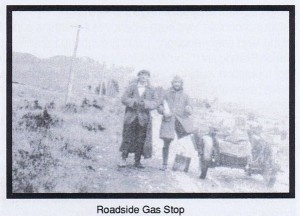 Motorcycling was very different then. Petrol, available at many country stores, was distributed in wooden cases containing two 4 gallon tins. Bulk delivery was introduced, at first only in the cities, in 1926. Some of the boys in Christchurch used to make up a witches brew mixing one part naptholene (really cheap at the gasworks) with one part kerosene, and a bit of paraffin. In those days 25 cents per gallon for fuel was a lot of money (1 gallon = 4.4 litres). Acetylene lamps were still common, and Jack says he’s often had to piss on the carbide to get the headlight going when short of water! Outside the city limits the roads were fairly basic. Even the Main South Road had big wind rows of shingle on it, though one of Jack’s brothers was glad enough to land in one when he was dumped off the back when their Scout blew a front tyre and slewed all over the road on a ride to Ashburton. They just stuffed the casing with grass and carried on!
Motorcycling was very different then. Petrol, available at many country stores, was distributed in wooden cases containing two 4 gallon tins. Bulk delivery was introduced, at first only in the cities, in 1926. Some of the boys in Christchurch used to make up a witches brew mixing one part naptholene (really cheap at the gasworks) with one part kerosene, and a bit of paraffin. In those days 25 cents per gallon for fuel was a lot of money (1 gallon = 4.4 litres). Acetylene lamps were still common, and Jack says he’s often had to piss on the carbide to get the headlight going when short of water! Outside the city limits the roads were fairly basic. Even the Main South Road had big wind rows of shingle on it, though one of Jack’s brothers was glad enough to land in one when he was dumped off the back when their Scout blew a front tyre and slewed all over the road on a ride to Ashburton. They just stuffed the casing with grass and carried on!
At Duckworth and Turner Jack cobbered up with an older workmate Bill Stevens, another keen motorcyclist, and together they pioneered motorcycle access to some then very inaccessible parts of the South Island. Stevens had an Indian Chief sidecar outfit, but with a young family was often a bit short of cash, and the teenage Kirner brought along his trusty Box Brownie camera and a few bob, as he puts it, to help with expenses (The photographs in this article have been reproduced from the 1994 article and are a testament to Jacks ability to take a good photograph, especially using a Box Brownie – McS). While on the road they lived largely on pies and what they could scrounge along the way, believing that God helps those that help themselves. Those pies must’ve been good back then ¦. Jack’s eyes still light up when he talks about them! He reckons gas was never a problem, they always carried a ‘three minute hose’, so called because that’s how long it took to syphon a tankful ¦ locking fuel caps on cars weren’t in vogue then, and anyway they didn’t like car owners much. Only rich buggers could afford them , Jack reckons. Justification , I believe it’s called. I guess a bloke who as a kid figured out that by soldering a thin wire to a penny you could get free chocolate bars from a penny slot-machine could live off the land easily enough. I was bought up to believe that Marlon Brando and The Wild One gave us motorcyclists our bad reputation, but now I’m not so sure. Hell, these guys weren’t even above snipping the occasional fence wire if they wanted a detour.
The big Indian outfit was a great tourer, reliable and robust. They carried tools, ropes, extra fuel and oil, and hung a spare tyre over the nose of the chair. Gum Dipped Dunlops were the best, the old chap recalls. New ones on the bike, and take the best of the old ones as the spare. There weren’t any bikes in the backblocks, and any you did meet would generally be Indians or Harleys. The motors on the English bikes were a bit underpowered for sidecars, and their lighter frames were prone to cracking. Looking at the shocking roads in some of the pictures he showed us, I’d say no bloody wonder! Leather caps and army greatcoats were standard riding kit, no electric vests and heated handlebars for these boys.
Jack thinks they were the first petrol powered vehicle to go right through the Molesworth Station route, and in 1924 they made the first motorised trip over the Grove Track between Picton and Havelock, and repeated the journey in 1927 or ’28. There were signs at either end warning This Road is Dangerous, No Vehicular Traffic. In places the pack track was so narrow they had to unbolt the sidecar and wheel it through after the bike, and they had to repeat this process to haul the outfit across slips and washouts with ropes and pulleys they attached to trees!
.
.
.
.
.
.
.
.
.
.
Bill and Jack covered a lot of miles on the West Coast. They rode in to the Dorothy Falls, behind Lake Kaniere, through conditions that would be hard work in places on a modern trail bike. Hard to believe, maybe, but the Kirner photo collection has the evidence in black and white. Roads on the coast then were mainly single lane, often just tracks, and passing oncoming traffic called for care. Logging trucks in the bush were bloody scary, you had to listen out for the racket of their exhaust brakes coming into blind corners.
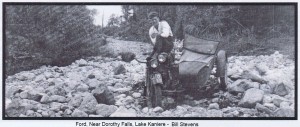 The service cars, latter day stage-coaches, were a worry too as they didn’t waste any time. Hustling along with their load of mail and passengers, they’d give a blast on their klaxon horn to clear the way. On a trip up the Buller Gorge, Bill’s big Indian was damned near pushed over the edge at Hawke’s Crag by one. Jack says that the sidecar wheel was hanging out in spcae over the drop to the river ¦. he jumped across onto the back of the bike and grabbed the mailcar’s mudguard to hold them up! He and Bill didn’t drink while riding, but they had a slug of rum each after untangling that lot!
The service cars, latter day stage-coaches, were a worry too as they didn’t waste any time. Hustling along with their load of mail and passengers, they’d give a blast on their klaxon horn to clear the way. On a trip up the Buller Gorge, Bill’s big Indian was damned near pushed over the edge at Hawke’s Crag by one. Jack says that the sidecar wheel was hanging out in spcae over the drop to the river ¦. he jumped across onto the back of the bike and grabbed the mailcar’s mudguard to hold them up! He and Bill didn’t drink while riding, but they had a slug of rum each after untangling that lot!
His mates 10/12 Indian made such an impression on Jack Kirner that when another one was advertised for fourty five pound ten, he scraped up all the cash he could raise and went to buy it. He says the owner bloody near cried, but took the thirty six quid, the best offer he’d had, and Jack rode away on a 1921 Indian Chief. He must’ve been a right young tearaway. His heroes were Charlie Blacklock (Shortie as Jack knew him, the first Kiwi to ride professional speedway in England), Chas O’Connor, and the other Broadsiders who raced at the Monica Park track. It sounds as though he modelled his riding style on theirs, sliding the Chief round shingle 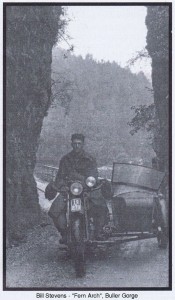 road bends and flying down the straights ¦. solo it was good for the ‘ton’ no trouble! Mind you, he does admit to renewing the big-end rollers three times.
road bends and flying down the straights ¦. solo it was good for the ‘ton’ no trouble! Mind you, he does admit to renewing the big-end rollers three times.
On Labour Weekend, 1926, Bill and Jack, both bikes with sidecars fitted, made the first motorised trip to the Ball Hut, and like most of their rides, it was a bit of an adventure. On the way in to Mount Cook, Bills machine threw its chain and stalled in the middle of the road. Jack came sliding around the corner ¦ at least 60 mph he reckons, and unable to stop in time, collided with Bill’s outfit, stoving in the nose of his chair, as you’ll see in the picture. All Bills fault’ he claims! (over sixty years later, Bills grandson blamed me because he dropped his Commando behind me after I was taken out by a car). Mobile again, they carried on to the Hermitage.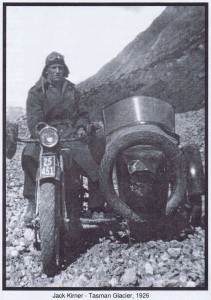
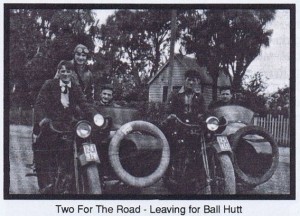
The road stopped there, and they headed up the Tasman Glacier following an unformed track over the boulders of the glacial moraine. Bill had to turn back when a rock cracked the sump of his bike. With the split tapped closed as best they could with Jack’s engineer’s hammer and jury rigged, he headed back to the Hermitage, using the auxilary hand pump to compensate for any oil loss. Jack stubbornly carried on and got right up to the Ball Hut, then rode slowly back, very aware that if he damaged his bike he’d have no assistance. On reaching Mount Cook village he found that Bill, probably because of the dubious condition of his rig, had headed off for Christchurch seven hours earlier. Setting out after him, he caught up later that night, almost running into the outfit stopped with a puncture. They camped the night and fitted another tyre in the morning, and when they returned to Christchurch the Indian agent, Charlie Bell, gave Bill a new chain and three pounds as a bonus for their achievement.
On a later trip they went through Arthur’s Pass and down to the Franz Josef Glacier, taking Bill’s son Eddie, only six or seven years old, along. Roads in South Westland were really primitive ¦ only the major rivers were bridged, and many of the fords were tidal. The big V-twins were not to be stopped though. With snorkel hoses fitted to the carburettors and Plasticine sealing the plug caps, they waded through some really deep crossings. Water didn’t seem to worry the ‘split-off’ type magnetos (Splitdorf). Check that shot of Bill in the Mataroa River!.
Reaching Franz Josef they managed to get the bikes up to the hostel, seven miles off the main road. As though they hadn’t had enough drama already, after walking the two miles to the glacier with young Eddie, they found a lone tourist on the ice who’d fallen and broken a leg, and carried him out. Never a dull moment.
Eddie, now over seventy himself, remembers going on many more trips. Jack rode on into the mid thirties, the continuing saga including among other things a near miss, brushing gloves with another rider in thick fog on Highway 1, and almost riding at full throttle into the flooded Waipara River one stormy night. His wife Ruth was a good pillion rider, but after one close shave too many, his mother-in-law persuaded him to swap the Indian for a Whippet car. Bill Stevens, who died about 1953, stuck with bikes pretty well all his life.
Still lively and active at 85, these days Kirner drives a tidy original XA Falcon 302 very competently. Handy to slip round to the local and get the half gallons filled, he says.
While he admires the technical development of todays motorcycles, he feels that they are too flimsy, too complicated to work on at the roadside, and wouldn’t ride away after a crash like the old ones. He’s even a bit worried about Harleys ¦ reckons they’re getting too flash and fancy!
Great meeting you Jack, long may your Indian Summer continue. ……………Rex Knight.
Time marches on for us all, and nothing is forever. Even though Jack Kirner passed away in 2000 his keeness to record his trips with photographs and share his life story with Rex will live on as a personal legacy. Many thanks to Jack and his family, and to Rex who took the time to listen.
Footnote: Wishing to record Jacks correct details for those who may want more information I searched the New Zealand Birth, Deaths and Marriages historical records and found that Jack was actually christened John Nicholas Kirner and that he was born in 1909. Including several male members of my family as well as John (Jack) it was common place to call those christened with the name John as Jack in the early 1900s.
John Nicholas Kirner (Jack) Born 24 December 1909 Died 28 September 2000
Ruth Kirner Born 3 March 1914 Died 1986.
